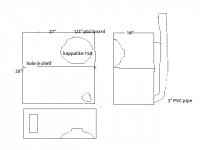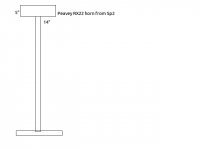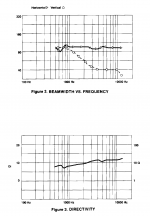Or if you live in the country just target practice outside during the day or get a guard dog....
I hate dogs and spend 4 days a week at summer camp in the summer.
Here is a 2 way that is ugly, big and maybe will be ignored by thieves. Bass cabinet is a partical board cabinet I salvaged last week. Tweeter is a Peavey plastic horn on a 8' pole. I have 2 RX22 (1.4") Peavey tweeters with horns. Shelf in cabinet gets a hole sawed to make a 5' long path from 15" woofer, continued with a PVC pipe out the back 6' long to make a 11' long resonant chamber. 40 hz tuning, right?
Woofer is a eminence kappalite-3015 crossed over at 1000 hz to avoid the response rise @ 1200 hz. Some peavey sP2 cross the horn over @ 1200 hz (SP2-XT) some at 800 hz (older SP2). I intend to put resistance in series with horn to cut down the response, and a zener diode clamp for huge pops when I trip over a line level cord or something.
Front & back of cabinet upgraded to 3/8" nemaLE board to avoid renting a truck to bring home MDF, then storing 4x8 sheets somewhere. NemaLE is very strong.
Volume 184 L. minus felt. Kappalite 3015 specs max 144 liters. Vas 153 L, Qts .34 xmax 5.9 mm sensitivity 100.8 db 1m1w
Here is a 2 way that is ugly, big and maybe will be ignored by thieves. Bass cabinet is a partical board cabinet I salvaged last week. Tweeter is a Peavey plastic horn on a 8' pole. I have 2 RX22 (1.4") Peavey tweeters with horns. Shelf in cabinet gets a hole sawed to make a 5' long path from 15" woofer, continued with a PVC pipe out the back 6' long to make a 11' long resonant chamber. 40 hz tuning, right?
Woofer is a eminence kappalite-3015 crossed over at 1000 hz to avoid the response rise @ 1200 hz. Some peavey sP2 cross the horn over @ 1200 hz (SP2-XT) some at 800 hz (older SP2). I intend to put resistance in series with horn to cut down the response, and a zener diode clamp for huge pops when I trip over a line level cord or something.
Front & back of cabinet upgraded to 3/8" nemaLE board to avoid renting a truck to bring home MDF, then storing 4x8 sheets somewhere. NemaLE is very strong.
Volume 184 L. minus felt. Kappalite 3015 specs max 144 liters. Vas 153 L, Qts .34 xmax 5.9 mm sensitivity 100.8 db 1m1w
Attachments
Last edited:
I think mastering rooms are too wide & too short, to put more floor space out where the musicians are. That is why IMHO they have to be non-echoic.
Adding to your point, in my limited conversations with mastering professionals, the mastering process is typically limited to listening into the mix and making sure there is a sonic consistency on a track to track basis (listening for anomalies) to make sure the final product best represents the editorial decisions made in the mixing stage. Spacial cues are already baked into the mix and how these translate when played back domestically is an uncontrollable variable. I should add that these remarks are from people who work more with studio work than classical recordings but it does apply there as well.
Last edited:
If thats all the mastering engineer did for me I'd be pissed off since I know better lol!
Making sure all the tracks fit together sonically on an album
Making sure the tracks fit sonically to the genre of music it belongs to that has already established norms (including classical recordings)
Generally bringing the best out of each song, sonically, in an artistically beautiful way
And the current gen; Making the song as loud as fking possible while maintianing all the best sonic qualities that it can.
Sonically, translates into tone, dynamics and harmonics. Mastering might be focused on the master track itself or mastering to each individual track and then combined and polished off...
"Spacial cues are already baked into the mix and how these translate when played back domestically is an uncontrollable variable." - This part sounds, strange...probably because I mix and master my own stuff so I can go make into the mix as needed....which pro mastering engineers do as well depending on how involved they are in the project...how much they care...etc But how these aspects translate into the domestic arena is not uncontrollable at all lol, maybe unpredictable to the nth degree, but as I sort of said earlier...monitoring with an implementation on expectation of averages (average cinema/living room/club/arenas etc) gives a happy median....just like aiming towards the middle of tonality of system playback (aiming for +/-0db for all criticized bands) is the standard as well...even if unobtainable, we do out best.
professional just implies being paid for work....half the people who regularly participate in this thread have better listening systems than the majority of mastering engineers I've come across in the FB group and no ones paying them...no what I mean?
Making sure all the tracks fit together sonically on an album
Making sure the tracks fit sonically to the genre of music it belongs to that has already established norms (including classical recordings)
Generally bringing the best out of each song, sonically, in an artistically beautiful way
And the current gen; Making the song as loud as fking possible while maintianing all the best sonic qualities that it can.
Sonically, translates into tone, dynamics and harmonics. Mastering might be focused on the master track itself or mastering to each individual track and then combined and polished off...
"Spacial cues are already baked into the mix and how these translate when played back domestically is an uncontrollable variable." - This part sounds, strange...probably because I mix and master my own stuff so I can go make into the mix as needed....which pro mastering engineers do as well depending on how involved they are in the project...how much they care...etc But how these aspects translate into the domestic arena is not uncontrollable at all lol, maybe unpredictable to the nth degree, but as I sort of said earlier...monitoring with an implementation on expectation of averages (average cinema/living room/club/arenas etc) gives a happy median....just like aiming towards the middle of tonality of system playback (aiming for +/-0db for all criticized bands) is the standard as well...even if unobtainable, we do out best.
professional just implies being paid for work....half the people who regularly participate in this thread have better listening systems than the majority of mastering engineers I've come across in the FB group and no ones paying them...no what I mean?
Last edited:
Camplo, the people I speak of have been heavily involved with helping people with home studios perfect their craft, whether through being entirely approachable online or hosting seminars at TapeOp conventions. They have also worked on platinum selling albums if that is any figure of merit. The vast majority of the editorial process of recording is done before the mastering stage. This is why it’s not uncommon for there to be notes to the mastering engineer to clue them in on things that were done deliberately in the mixing stage that might otherwise seem unintentional when played back in the mastering suite.
Particular processes of both mixing and mastering may depend on many factors, of which the genre of music is probably the most important.
@indianajo, how did you arrive at that long (exhaust? 😀) pipe for your 184L cab with Fb 40 Hz?
A quick and dirty sim yields either 2 x Ø 9.4 cm ports (at least 20 cm apart), or a single Ø 15.0 cm vent with a length of 6.7 cm.
Do you intend to use either the A/A 9045-1, or A/A 9040-1 horn?
The latter lacks pattern flip in the passband.
@indianajo, how did you arrive at that long (exhaust? 😀) pipe for your 184L cab with Fb 40 Hz?
A quick and dirty sim yields either 2 x Ø 9.4 cm ports (at least 20 cm apart), or a single Ø 15.0 cm vent with a length of 6.7 cm.
Do you intend to use either the A/A 9045-1, or A/A 9040-1 horn?
The latter lacks pattern flip in the passband.
Attachments
dog lives matter!
and not to slight the job of a mastering engineer but it has changed greatly since the days of vinyl when a mastering engineer would be looking to make the recorded music fit the medium, fast forward into the new era where dynamic range and frequency standards no longer rule the game anybody with a few process modules a compressor and a digital recorder think they are mastering engineers...
and not to slight the job of a mastering engineer but it has changed greatly since the days of vinyl when a mastering engineer would be looking to make the recorded music fit the medium, fast forward into the new era where dynamic range and frequency standards no longer rule the game anybody with a few process modules a compressor and a digital recorder think they are mastering engineers...
Despite having a friend that runs a vinyl store and another friend that just bought a SL1200Mk7, I ditched traditional media more than 15 years ago.
Regarding studio gear, there are tons of excellent DAWs, VSTs, etc. available, so there is no longer any need to fill racks with compressors and samplers or collect expensive vintage synths.
Regarding studio gear, there are tons of excellent DAWs, VSTs, etc. available, so there is no longer any need to fill racks with compressors and samplers or collect expensive vintage synths.
Last edited:
Thanks for looking. Speed of sound is 880 ft/sec. Desired bass boost is 40-90hz. Vent has an open end & fixed end @ speaker so half wavelength of 40 hz is 11'. Will consider your vent dimensions, looks like a Peavey SP2-TTI front. Idea for long resonator came from Neil Blanchard "20 hz" reflex cabinet in a previous post with a long internal bulkhead that would weigh a lot.@indianajo, how did you arrive at that long (exhaust? 😀) pipe for your 184L cab with Fb 40 Hz?
A quick and dirty sim yields either 2 x Ø 9.4 cm ports (at least 20 cm apart), or a single Ø 15.0 cm vent with a length of 6.7 cm.
Do you intend to use either the A/A 9045-1, or A/A 9040-1 horn?
The latter lacks pattern flip in the passband.
Sims require $200 a year to Microsoft for updates & $800 a year to ***** for new PC's, so I don't participate. The burglar left this old PC as useless. I've used browser based Herokuapp Circuit Simulator which produces 1 datapoint at a time, not graphs. Some explanation of the underlying math of vented reflex would be useful. Since the only eminence (Ky made) 15" driver that doesn't rise 5 db above 1000 hz is a vented kappalite 3015.
I have Peavey 5"Tx14"Wx6"Dx1.4" horns from Ebay with vertical 1/2" apature salvaged from apparently a SP2-XT or close relative. No part #. Peavey SP2-XT spec plots horizontal dispersion of 1 khz & 2 khz down 2 db @ 22.5 deg horizontal & 8hz flat , which is fine for my music room. I loved my SP2-XT that were stolen.
Goal of salvage cabinet is not buying another circular saw (to be stolen) nor a big table to saw on. Plus not hauling around 4x8 sheets mdf on my bicycle. (no motor vehicle). I have a jigsaw for cutting round holes. I can fill ugly 26"x27"x16" cabinet (worn veneer) with sofa cushion+bulkhead to cut volume to 144 L max on driver spec. Trying to avoid weight: the SP2-XT @ 94 lb were too heavy for me to mount on 6' high poles. I hired a mover. woofers will have to be above Hammond organ since they reproduce voice up to 1100 hz.
Last edited:
Sims require $200 a year to Microsoft for updates & $800 a year to ***** for new PC's, so I don't participate. The burglar left this old PC as useless.
That seems an unreasonable high amount of money.
There are many ways to minimize the expenditure on PCs and software.
VitiuxCAD is an excellent tool, free of charge.
Speed of sound is 880 ft/sec.
If memory serves, speed is 1100 ft/sec, 343 m/sec. Or maybe my memory is shot.
system requirements for vitiuxcad is windows xp, 7,8, or 10.VitiuxCAD is an excellent tool, free of charge
I use linux. Doesn't require 40 minutes of updates every 3rd time you turn the PC on.
Every PC I saw for sale last summer in Best Buy & Staples were made in *****. I don't buy things made in *****. I'm funny looking, ***** just locked up 600000 ethnic people that looked funny and spoke the wrong language.
I bought a speaker book from ebay authored David Weems. Maybe it is old enough to have some equations in it. If I'm unlucky it will arrive full of plans for cutting up plywood.
You're right. wikipedia has it in ft/sec this time, last time I looked it was only in km/hour. Rounding error, 880 vs 1100. so my 1/2 wavelength resonator @40 hz could be 5' cavity+9' pipe. I have 11' ceiling, no problem.speed of sound is 1100 ft/second
Some question of using 3 resonators, 40 hz, 60 hz, 80 hz to cover 40-90 hz 25 db dip of all 15" drivers. Plastic drain pipe is really cheap and really ugly.
Conn organ had an auxillary speaker that was four 4"x9" drivers under a dozen pipes. Must sound good, still draws a big price on e-bay. Or maybe just looks good, I never heard one.
Last edited:
Gm [/B]you are hilarious lol!!!
'Glad' you find the long term physical, financial suffering cum 'cautionary tale' so entertaining.
dog lives matter!
and not to slight the job of a mastering engineer but it has changed greatly since the days of vinyl when a mastering engineer would be looking to make the recorded music fit the medium, fast forward into the new era where dynamic range and frequency standards no longer rule the game anybody with a few process modules a compressor and a digital recorder think they are mastering engineers...
lol no lies there....I truly do mix/master my own material, I have been for the last 10+ years... but not to say I am the god of Mastering....The first time I felt entitled enough to call myself such was when I figured out I knew more about sound reproduction than other people who actually charged people money for the service....I'm just doing it for me, and the music that I produce...more less passion/hobby.
Brinkman - I wasn't exactly disagreeing with you, I just expanded upon the ideas they left you with. To say that all I'd have to do is adjust the tone of the a 2 channel file and walk away...is a lie...at the very least tone and dynamic range and harmonic content...and if thats all I had to do..
Mastering engineer are supposed to have accumulated superior hardware and playback systems (that the other people down the chain couldn't afford) in order to do this task...otherwise there is no need for them.
What!? did this really happen?! I thought you were speaking the theoretical, still the way you worded it was still funny lol'Glad' you find the long term physical, financial suffering cum 'cautionary tale' so entertaining.
Some explanation of the underlying math of vented reflex would be useful. Since the only eminence (Ky made) 15" driver that doesn't rise 5 db above 1000 hz is a vented kappalite 3015.
Eminence released a few cabinet designs for the Kappalite (attached).
In Vituixcad I got a similar results. The driver should work just fine in a 184 liter cab, as long as you don't tune the ports too low.
Attachments
thanks a lot. I wasn't aware eminence had this resource available. Large cabinet design has two 4" diameter port, which works well with PVC pipe from lumberyard.Eminence released a few cabinet designs for the Kappalite (attached).
Dr. Geddes and friends can you help me master the concept of Group delay....the best impression I have yet is that Group delay is a measure of the amplitude envelope where the initial phase entry position represents 0ms....Thus....group delay in ms is the time it takes for the diaphragm to reach its peak amplitude....
Im almost certain that in the electrical domain group delay is something completely different than what it means for the audio realm. If true....it is the vice for the confusion that follows.
Im almost certain that in the electrical domain group delay is something completely different than what it means for the audio realm. If true....it is the vice for the confusion that follows.
Here you go Camplo, by far the best explanation of group delay that I've found.
Has a lot of material concerning wavelets too, a very interesting project i've got going on right now.
Merlijn van Veen - Group Delay 101
Has a lot of material concerning wavelets too, a very interesting project i've got going on right now.
Merlijn van Veen - Group Delay 101
- Home
- Loudspeakers
- Multi-Way
- Is it possible to cover the whole spectrum, high SPL, low distortion with a 2-way?




